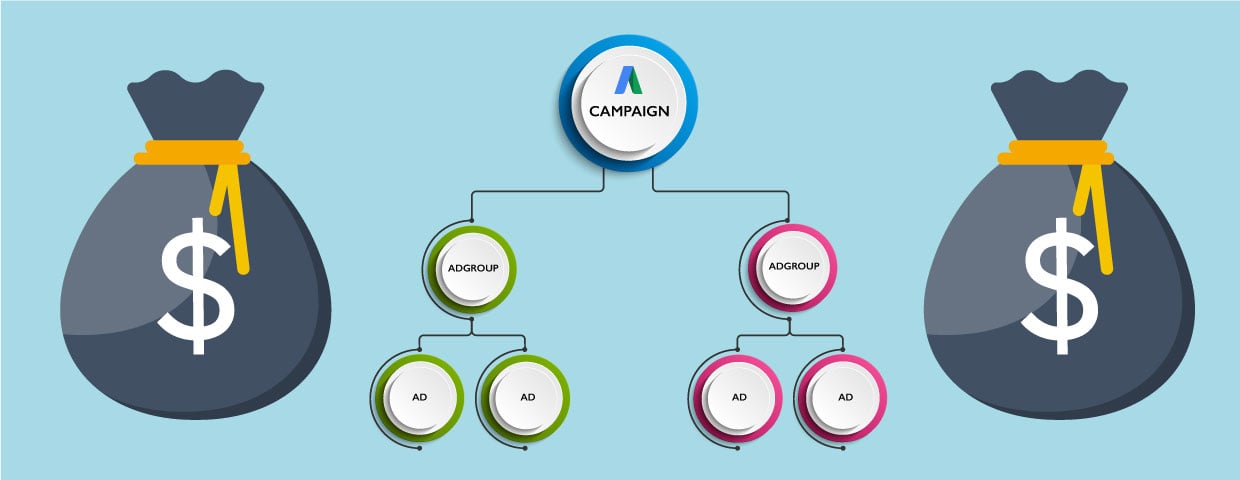Organizing Your PPC Campaign & Setting Budgets
Posted by Nikki Wardle on Jun 23, 2017 11:38:00 AM

If you have had experience running a Pay Per Click campaign using Google’s platform AdWords, then you know how important it is to organize your campaign properly and allocate the right amount of your ad spend budget to each campaign. The execution and overall success of your advertising campaign will depend on each campaign's targeted locations, demographics, keywords, landing pages, and how all of those relate to each ad group and overall campaign.
Let’s explore the different elements of Google’s AdWords platform and examples of how to organize your next PPC campaign.
Campaigns
Campaigns are the highest level of organization and are best defined as a set of ad groups, ads, keywords and bids that draw from the same overall budget, target location, schedule, device setting and more. They are organized for different products or services that you offer. Within an AdWords account, you can run one or more ad campaigns at a time. A best practice for naming and organizing a campaign is to keep the products you’re selling broad. A great example of this would be if you run a furniture store that also offers restoration services. You should have a campaign for selling new furniture, and one for providing restoration services. These are both services/products that you supply from the same location, but have different target markets, thus needing different campaign settings and budgetary limits.
Ad Group
Within your campaign, you will have separate Ad Groups. This is where you will take your product/services and break it down into a more narrow focus. Continuing with our furniture store example, the campaign focusing on furniture can now be divided into bedroom furniture, family and living room furniture and dining room furniture. Breaking down each room into adgroups will allow you market to people who want a chair for their living room as opposed to someone who is looking for dining room chairs.
Ads
Ads are the text or images that are displayed on top of a search result that tells the searcher about your service or product. There are many benefits for having multiple ads in each Adgroup. First, it allows more keyword variation for each ad. You can also test different call-to-action text and see which is performing better and what ad text if falling flat. You can also have different ad types such as display ads, shopping ads and call-only ads. There are many more benefits, so for the interest of not making this blog post a novel, we'll end it there.
Now that you have a good idea of how to organize your AdWords campaigns, let's look at some of the best practices for setting a budget.
Setting A Budget
The biggest mistake I see with companies when they are setting ad spend budgets is they set a total dollar amount from the beginning. You wouldn't go car shopping and say, "I'm going to spend 32,456.08 for the car I want," so why would you do the same for paid campaigns?
The answer is, you wouldn't, and you won't.
We're not suggesting that there should be no limit to the amount you spend, just look at all of the information before determining a final budget for your ad spend campaigns.
1. What is the value of a sale, lead, or email address to you
One of the most important factors to look at when determining your pay-per-click budget is the value of what a sale, lead, event or an email address is to your business. A budget is going to be very different for a company that sells stickers than our company that sells furniture. The value of that customer is very different.
Let's look at our furniture store again. Every time an order comes in from their website, they make an average profit of $100. They also see on average 1 completed online sale for every 10 website visitors. If our furniture business sets a maximum cost-per-click (CPC) bid of $10, their ad spend cost would equal what they profit, or simply put, they would break even. For the business to continue to be profitable, they would have to set maximum CPC bid less than $10.
2. What is competition level of your marketing for paid ads
Before starting any campaign, Google AdWords provides the Keyword Planner to show estimated traffic and average cost and competition for each of your keywords. This tool will help you decide which keywords to ditch and which to keep. From here, you will have an idea of how much you should set your daily budget at to achieve your goals.
3. WHAT IS your goal
Simply stating you want to increase online sales does not qualify as a goal, at least not one that you can use to set a budget. Let looks as some real numbers to work with.
Our furniture store wants to increase online sales by two per day, or 60 more sales in a month. We know that 1 out of every 10 clicks results in a completed online sale. Since their profit is $100 per sale, we will set our max cost per click at $7. So to get two sales, we will need 20 clicks, which will cost $140 per day, or $4200 per month.
I hope I have shed some light on how to effectively organize your campaigns and set your monthly budgets to get the best bang for your buck!
Written by Nikki Wardle
Nikki has a degree in Marketing from Boise State University and worked as an Inbound Marketing Specialist at Tribute Media from 2014 to 2019. She's a Google Whiz and dog lover, now serving as a marketing director for a local veterinary clinic.


